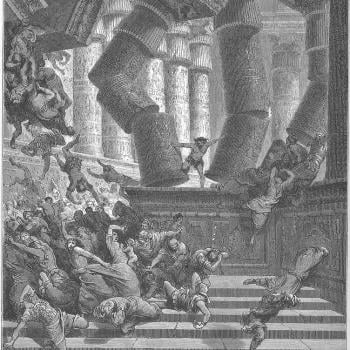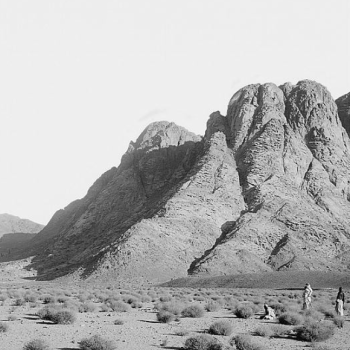Bart Ehrman is one of the most well-known and influential critics of traditional Christianity and the inspired Bible (“anti-theists”) writing today. Formerly, in his own words, he was “a fundamentalist for maybe 6 years; a conservative evangelical but not extreme right wing for maybe 5 years more; and a fairly mainstream liberal Christian for about 25.” The primary reason he gives for having lost his faith is the problem of evil (a very serious topic I have dealt with many times). He stated on 3-18-22 in a comment on his blog: “I could no longer explain how there could be a God active in this world given all the pain and misery in it.” I don’t question his sincerity, good intentions, intellectual honesty, or his past status as a Christian; only various opinions which Christians must (in consistency) regard as erroneous.
Dr. Ehrman “received his PhD and MDiv from Princeton Theological Seminary, where he studied textual criticism of the Bible, development of the New Testament canon and New Testament apocrypha under Bruce Metzger.” He has written 30 books, which have sold over two million copies and have been translated into 27 languages.
Ehrman explains that the purpose of his blog is “to disseminate scholarly knowledge of the New Testament and the earliest periods of the Christian church to a non-scholarly audience, . . . Every post is rooted in scholarship – not just my own but that of thousands of scholars who have worked for centuries on understanding the historical Jesus, the New Testament, and the origins of Christianity.” Well, the conclusions of scholars are only as good as the solidity and truthfulness of the premises by which they are operating.
This is one of a series of reply-papers, in which I will address many of his materials from the perspective of archaeology, history, and exegesis.
*****
I am responding to his article, “Biblical Anachronisms: The Philistines and Beersheba” (6-30-16). His words will be in blue.
[T]he historical Moses (if there was one) (which I doubt) could not have written parts of the Pentateuch (I don’t think he wrote any of the parts) (OK, since, among other things, I don’t think he existed) because of the mention of the people the “Philistines” and the city of Beersheba, neither of which existed in the thirteenth century BCE, when he must have lived, if he lived.
Here is a case in which he is making two negative claims. In the case of the Philistines prior to c. 1200 BC, it’s a matter of them being known by a different name, but still in existence. In the case of Beersheba, Ehrman is right that it didn’t exist as a town or city in Moses’ time, but wrong about the Bible supposedly claiming that it did.
As so often with anti-theists (and I have interacted with many of the prominent ones online): they seem to be unfamiliar with the Christian (and often also archaeological / historiographical) replies to their claims, and simply parrot the prevailing supposedly certain “dogmas” of skeptical and theologically liberal academia. Both of these supposed “anachronisms” are rather easily answered.
Genesis 10:14 (RSV) Pathru’sim, Caslu’him (whence came the Philistines), and Caph’torim.
Cambridge Bible for Schools and Colleges comments on this passage:
The parenthetical clause within the brackets seems to be out of place. According to Deuteronomy 2:23, Jeremiah 47:4, Amos 9:7 the Philistines came out of Caphtor. Accordingly, we may conjecture the clause originally stood after the word “Caphtorim,” and has been accidentally transposed. On the other hand, this explanation seems so obvious, that some scholars consider that the clause “whence … the Philistines” is in its right place, but that the words “and Caphtorim” are only a gloss on the mention of “the Philistines.”
Deuteronomy 2:23 As for the Avvim, who lived in villages as far as Gaza, the Caph’torim, who came from Caphtor, destroyed them and settled in their stead.) [see more info. on the Avvim]
Jeremiah 47:4 . . . the LORD is destroying the Philistines, the remnant of the coastland of Caphtor.
Amos 9:7 . . . [God]: “Did I not bring up Israel from the land of Egypt, and the Philistines from Caphtor and the Syrians from Kir?
Josephus‘ Antiquities of the Jews i.vi.2, . . . placed them explicitly in Egypt . . . using extra-Biblical accounts [he] provides context for the migration from Caphtor to Philistia. He records that the Caphtorites were one of the Egyptian peoples whose cities were destroyed during the Ethiopic War. (Wikipedia, “Caphtor”)
Here is the passage in question:
Now all the children of Mesraim, being eight in number, possessed the country from Gaza to Egypt, though it retained the name of one only, the Philistim; for the Greeks call part of that country Palestine. As for the rest, Ludicim, and Enemim, and Labim, who alone inhabited in Libya, and called the country from himself, Nedim, and Phethrosim, and Chesloim, and Cephthorim, we know nothing of them besides their names; for the Ethiopic war, [*Antiq. b. ii. chap. x.] which we shall describe hereafter, was the cause that those cities were overthrown.
What Josephus calls the “Ethiopic War” occurred during the reign of Pharaoh Thutmose II (1493-1479 BC).
A location called Kaptar is mentioned in several texts of the Mari Tablets and is understood to be reference to Caphtor. An inscription dating to c. 1780-1760 BCE mentions a man from Caphtor (a-na Kap-ta-ra-i-im) who received tin from Mari [Syria]. Another Mari text from the same period mentions a Caphtorite weapon (kakku Kap-ta-ru-ú). Another records a Caphtorite object (ka-ta-pu-um Kap-ta-ru-ú) which had been sent by king Zimrilim of the same period [r. 1775-1761 BC], to king Shariya of Razama. A text in connection with Hammurabi [r. c. 1792-1750 BC] mentions Caphtorite (k[a-a]p-ta-ri-tum) fabric that was sent to Mesopotamia via Mari. An inventory thought to be from the same era as the previous texts mentions a Caphtorite vessel (GAL kap-ta-ri-tum) (probably a large jug or jar). (Wikipedia, ibid.)
Trude Dothan (d. 2016) received the coveted Israel Prize for archaeology in 1998, in recognition for her many years of excavating (at Deir el-Balah, Hazor and Qasile) and teaching (at Hebrew University, Princeton, New York University, Brown University and the University of California at Berkeley). One of the world’s leading authorities on the Philistines, Dothan is the author of The Philistines and Their Material Culture (Israel Exploration Society, 1982) and, with her husband, Moshe, of People of the Sea (Macmillan, 1992).”
She explains the well-accepted theory that the Philistines came originally from Crete, and thus reflected that background and the larger historical and cultural influence of the Mycenaean civilization of Greece (1600-1100 BC):
The homeland of the Philistines, Caphtor (Amos 9:7), is generally recognized by scholars as Crete, (although some believe Caphtor to be located in Cilicia in Asia Minor.)
In other Biblical references, the Philistines are synonymous with the Cherethites; that is Cretans (see Zephaniah 2:5 and Ezekiel 25:16). Various Biblical traditions suggest that the Caphtorim (or at least some of them) are to be identified with the Cherethites. Thus the Biblical sources seem to link the Philistines with a previous home in Crete. . . .
The detailed Biblical account of Goliath’s armor and weaponry is a vivid description of a Philistine warrior in full battle dress:
“And he had a helmet of brass upon his head, and he was armed with a coat of mail. … And he had greaves of brass upon his legs, and a target of brass between his shoulders. And the staff of his spear was like a weaver’s beam, and his spear’s head weighed six hundred shekels of iron; and one bearing a shield went before him.” (1 Samuel 17:5–7)
Goliath’s dress and armour (bronze helmet, coat of mail, bronze greaves [leg guards], and javelin) as well as the duel between champions are all well-known features of Aegean arms and warfare. They clearly indicate Aegean traditions carried on by the Philistines. The 12th century Warriors’ Vase from Mycenae shows Mycenaean warriors very similarly equipped. . . .
The shapes and decorative motifs of Philistine pottery were a blend of four distinct ceramic styles: Mycenaean, Cypriot, Egyptian, and local Canaanite. The dominant traits in shape and almost all the decorative elements were derived from the Mycenaean repertoire, and, as we have said, point to the Aegean background of Philistine pottery Philistine shapes of Mycenaean origin include bell-shaped bowls, large kraters with elaborate decoration, stirrup jars for oils and unguents, and strainer-spout beer jugs; the latter no doubt served as centerpieces at many a Philistine party. A few of the many decorative motifs are stylized birds, spiral loops, concentric half-circles, and scale patterns. Although Philistine vessels were richly decorated with motifs taken from the Mycenaean repertoire, these motifs were rearranged and integrated with other influences to create the distinctive “signature” known as Philistine. . . .
Female pottery figurines also reflect Philistine cult origins and beliefs. The “Ashdoda” is the only complete example of a well-defined type that was common from the 12th to the eighth century B.C. The Ashdoda figure is probably a schematic representation of a female deity and throne. It is clearly related to a grouping known throughout the Greek mainland, Rhodes and Cyprus—a Mycenaean female figurine seated on a throne, sometimes holding a child. These Mycenaean figurines are thought to represent a mother goddess. . . .
Burial customs are generally a sensitive indicator of cultural affinities, and Philistine burial customs reflect the same fusion of Aegean background with Egyptian and local Canaanite elements that distinguishes every other aspect of their culture. (“What We Know About the Philistines”, Biblical Archaeology Review, July/August 1982)
Genesis 26:1 Now there was a famine in the land, besides the former famine that was in the days of Abraham. And Isaac went to Gerar, to Abim’elech king of the Philistines.
I believe that Moses lived from c. 1340 or 1330 BC to c. 1220 or 1210 BC (Late Bronze Age IIA and IIB, for the Near East), and that Abraham was born around 1880-1860 BC (Middle Bronze Age I) at the latest: based on the conclusions of Egyptologist and archaeologist Kenneth A. Kitchen. This period was during the . In 1956, the eminent Israeli archaeologist Yohanan Aharoni identified the Tel Haror site as the biblical Gerar. It’s located in the western Negev Desert of Israel, between Gaza and Beersheba, some 14 miles from the Mediterranean Sea. This is the ancient territory of the Philistines. Could it have been visited by Isaac, as the Bible states? Yes!
Israeli archaeologist Avner Raban (1937-2004) wrote a very educational article in 1991, entitled, “Minoan and Canaanite Harbours.” Aegaeum 7: 129-46. It has many tie-ins to our subject matter, and supports a notion that commerce may have been what brought the Philistines from Crete to Canaan (and to Egypt):
Cretan artifacts were found in [Egyptian] 12th dynasty [1991-1802 BC] sites in many places along the Nile Valley (such as Karun, Gahob, Abydos and even in the oasis of Harageh). Egyptian artifacts of that period were found at Cretan Middle Minoan [2100-1600 BC] context . . . Similar Middle Minoan II [1800-1700 BC] artifacts were found in Levantine trade centres such as Byblos [Lebanon], Ugarit [Syria] and even the inland Qatna [Syria] . . .
Sargon I [20th-19th c. BC] of Akkad (Agade) mentioned Crete (. . . the biblical Kaphtor) together with sources of metal ores from over the Mediterranean, already in the 24th century B.C.E. and a broken Akkadian cuneiform inscription of around 1800 B.C.E. was found on the island of Kythera [island between the Greek mainland and Crete]. An early Babylonian cylinder seal of about the same period in Tholos B in Platanos, in the Messara Valley in Crete. (p. 144) [my bracketed material and links]
Australian archaeologist Robert Merrillees reports in his 2003 article, “The First Appearances of Kamares Ware in the Levant.” Egypt and the Levant 13: 127-42, on the discovery of a portion of a Minoan cup from around 1800 BC, that was found in Ashkelon, part of ancient Philistia, on the coast.
At Tel Kabri in present-day northwest Israel on the coast, are archaeological remains “containing one of the largest Middle Bronze Age (2,100–1,550 BCE) Canaanite palaces in Israel” (Wikipedia). The article continues:
Among the discoveries at the site by the two full-scale archaeological expeditions, two have attracted particular attention from the archaeological community. The first finding to come to international attention was the discovery of Minoan-style frescoes in the palace at Kabri. As of 2015, these are the only Minoan paintings ever discovered in Israel.
Sources:
Cline, E. H.; Yasur-Landau, A.; Goshen, N. (2011). “New Fragments of Aegean-Style Painted Plaster from Tel Kabri, Israel”(PDF). American Journal of Archaeology. 15 (2).
Science Daily (7 December 2009). “Remains Of Minoan-Style Painting Discovered During Excavations Of Canaanite Palace”.
These have been dated by Cline et al to the 17th century BC (p. 245; Abstract).
No one needs to hold that these earlier Philistines from Crete were a great nation prior to the 12th century BC, when everyone believes they quickly became so. But archaeology suggests that there were enough of them present in the region, to be mentioned as such in the early Bible passages.
Nature (7-4-19) reports:
The Philistines appear repeatedly in the Bible, but their origins have long been mysterious. Now genetic evidence suggests that this ancient people trace some of their ancestry west all the way to Europe.
Choongwon Jeong and Johannes Krause at the Max Planck Institute for the Science of Human History in Jena, Germany, and their colleagues analysed the DNA of ten ancient people whose bones were found in Ashkelon, a Philistine city located in modern-day Israel. The DNA suggests an influx of people of European heritage into Ashkelon in the twelfth century BC. The individuals’ DNA shows similarities to that of ancient Cretans, but the team warns that it is impossible to specify the immigrants’ homeland because of the limited number of ancient genomes available for study.
The closest DNA match was Crete: about 43%. So once again, we see that archaeology has supported biblical accuracy. The Philistines (according to genetics) likely originated in Crete, just as the Bible stated in Genesis, Jeremiah, and Amos. And significant numbers of them were present in Egypt and Canaan before 1200 BC: again, precisely as the Bible states. See another more recent article about the genetic background of the Philistines: “The Philistines were Likely of Greek Origin, According to DNA” (Philip Chrysopoulos, Greek Reporter, July 31, 2021).
Note also that when the Bible mentions Isaac’s visit to the Philistine king Abim’elech ( Kitchen thinks he was born around 1850-1820 BC), no mention is made of the five famous cities of Philistia: Gaza, Ashdod, Ash’kelon, Gath, and Ekron (Joshua 13:3). They were much more important later. All that was mentioned was Gerar, which I have shown from archaeology was flourishing at that time. But if the Bible were so anachronistic, as charged, it seems like it would have mentioned them. Instead, it’s historically accurate.
***
The case of Beersheba is different, as briefly noted above. John J. Bimson, in his chapter, “Archaeological Data and the Dating of the Patriarchs”, in A.R. Millard & D.J. Wiseman, editors, Essays on the Patriarchal Narratives. Leicester: IVP, 1980. pp.59-92, provides a response to the skeptical argument:
Beersheba Tel Beersheba (Tell es-Seba’) completely lacks pre-Iron Age remains. It does not therefore bear on the question of whether the patriarchal narratives relate better to MB [Middle Bronze Age] I [2100-2000 BC] or MB II [2000-1550 BC]. . . .
[T]he references to Beersheba in the patriarchal narratives do not actually require a settlement on the site at the time in question. Sarna has argued thus in reply to Van Seters: ‘The biblical passages refer only to a well and a cultic site…. No king or ruler is mentioned, and no patriarch ever has dealings with the inhabitants of Beersheba. The only description of Beersheba as a “city” in the patriarchal narratives is a late editorial note (Gn. 26:33) which clearly has nothing to do with the narrative context, and which views the material through the eyes of a later age.'[109] In 1967, Aharoni held the view that the absence of early archaeological evidence does not contradict the patriarchal narratives, which, he then suggested, have only the area of Beersheba in mind, not a town.[110] . . . (pp. 75-76)
SOURCES
[109] N. M. Sarna, Biblical Archaeology Review 3/4, 1977, p.9.
[110] Yohanan Aharoni in Winton Thomas, (ed.), Archaeology and Old Testament Study (Clarendon, Oxford, 1967), p.389.
The biblical data appears perfectly consistent with this scenario (it was a nomadic encampment). Beersheba is mentioned eleven times in Genesis (RSV). None of the passages require the interpretation of even a town, let alone a city. The very first mention, in Abraham’s time (Gen 21:14) refers to “the wilderness of Beer-sheba.” As for Genesis 26:33 being a “late editorial note”, Ellicott’s Commentary for English Readers (which was written in 1905; thus it is no polemics against “undesired” archaeological results) observed:
There was no city at this time at Beer-sheba, but one is mentioned at the conquest of Canaan by Joshua (Joshua 15:28). This note, as is the case generally with those which speak of a thing existing “unto this day,” was added by Ezra and the men of the Great Synagogue, after the return from Babylon (comp. Genesis 22:14); and its meaning is that, whereas Abraham’s name had been forgotten while the place lay desolate, this remarkable coincidence of the water being again found, just when the covenant had been confirmed by the customary sevenfold sacrifice, so impressed the minds of the people that the title of Beer-sheba never again passed into oblivion.
According to radiocarbon dating, the Chalcolithic settlement in Beersheba City dates to about 4200–4000 B.C.E. After its abandonment, human occupation returned to Beersheba City and Tel Shebaʾ only in the Iron Age.
Genesis 35:20 and Jacob set up a pillar upon her grave; it is the pillar of Rachel’s tomb, which is there to this day.*Deuteronomy 34:6 and he buried him in the valley in the land of Moab opposite Beth-pe’or; but no man knows the place of his burial to this day.*Joshua 8:28 So Joshua burned Ai, and made it for ever a heap of ruins, as it is to this day.*2 Samuel 18:18 Now Ab’salom in his lifetime had taken and set up for himself the pillar which is in the King’s Valley, for he said, “I have no son to keep my name in remembrance”; he called the pillar after his own name, and it is called Ab’salom’s monument to this day.
This notion of the scribe Ezra (5th c. BC) making slight additions to the Bible is not an “after the fact” rationalization of alleged anachronisms, either, since, for example, Charles Buck’s Theological Dictionary, published in 1802 referred to it (“Bible”):
Ezra made additions in several parts of the Bible, where any thing appeared necessary for illustrating, connecting, or completing the work; in which he appears to have been assisted by the same Spirit in which they were first written. Among such additions are to be reckoned the last chapter of Deuteronomy, wherein Moses seems to give an account of his own death and burial, and the succession of Joshua after him. To the same cause our learned author thinks are to be attributed many other interpolations in the Bible, . . .
See also the Jewish article, “Verses Added to the Torah at a Later Date: The Phenomenon and Its Ramifications (3)” by Rav Amnon Bazak (9-21-14), and “The Book That Changed: Narratives of Ezran Authorship as Late Antique Biblical Criticism”, by Rebecca Scharbach Wollenberg; Journal of Biblical Literature, Vol. 138, No. 1 (2019).
This dynamic of later editors would likely apply to references to the Philistines in the Pentateuch as well. By Ezra’s time, the Philistines were known by that name, whereas further back, during Moses and Abraham, they were known as Caphtorim. Same people, same background, but with a different name at one point: which is not at all uncommon in history.
***
Practical Matters: Perhaps some of my 4,000+ free online articles (the most comprehensive “one-stop” Catholic apologetics site) or fifty books have helped you (by God’s grace) to decide to become Catholic or to return to the Church, or better understand some doctrines and why we believe them.
Or you may believe my work is worthy to support for the purpose of apologetics and evangelism in general. If so, please seriously consider a much-needed financial contribution. I’m always in need of more funds: especially monthly support. “The laborer is worthy of his wages” (1 Tim 5:18, NKJV). 1 December 2021 was my 20th anniversary as a full-time Catholic apologist, and February 2022 marked the 25th anniversary of my blog.
PayPal donations are the easiest: just send to my email address: [email protected]. You’ll see the term “Catholic Used Book Service”, which is my old side-business. To learn about the different methods of contributing, including 100% tax deduction, etc., see my page: About Catholic Apologist Dave Armstrong / Donation Information. Thanks a million from the bottom of my heart!
***
Photo credit: David Giving Thanks to God After the Death of Goliath [the most famous Philistine], attributed to Charles Errard the Younger (1606-1689) [public domain / Wikimedia Commons]
***
Summary: Influential Bible critic & anti-theist Bart Ehrman claims that the biblical text is anachronistic regarding Philistines, Beersheba, & much more. I refute these notions.














